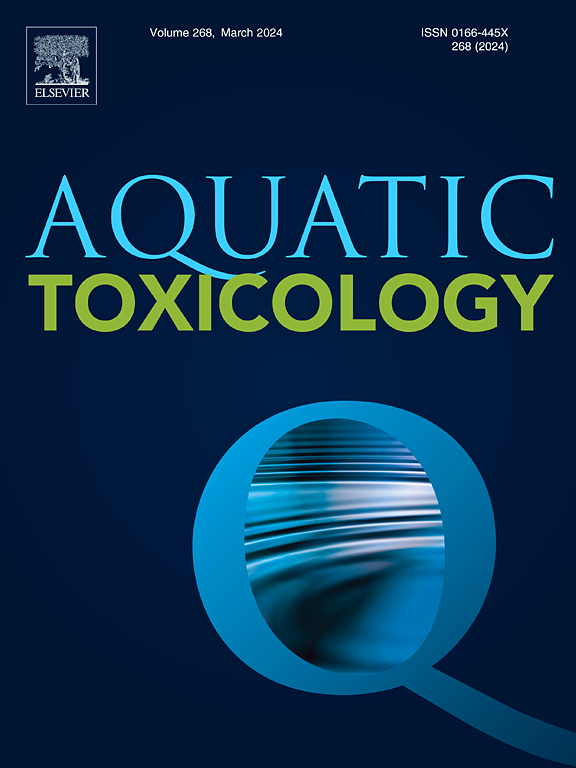纳米塑料和新出现的污染物混合物在紫贻贝中的性别效应
IF 4.1
2区 环境科学与生态学
Q1 MARINE & FRESHWATER BIOLOGY
引用次数: 0
摘要
贻贝的繁殖发生在水柱中,如果配子发生成功,配子就会暴露在周围的污染物中。纳米塑料和其他新兴污染物已经引起了广泛的关注;然而,它们对具有性别分化的贻贝生殖组织的影响很少。在这里,聚苯乙烯纳米颗粒(50 nm;10µg/L),细胞毒性药物5-氟尿嘧啶(10 ng/L),以及两者的混合物,在暴露21天后进行多生物标志物评估,并在28天后进行纳米塑料积累评估。评价了其对超氧化物歧化酶、过氧化氢酶、谷胱甘肽- s -转移酶和脂质过氧化活性的影响。此外,还计算了混合物中的协同和拮抗相互作用。证据权重模型还用于详细说明相对于单独的聚苯乙烯纳米颗粒和混合物中的生物标志物结果的危险水平。纳米塑料的积累具有性别和时间特异性,以雌性为主。根据数据集,细胞毒性药物和纳米塑料之间的协同相互作用使得这种组合比单个压力源要危险得多。证据权重模型还证实,女性在长期暴露时间下比男性更容易受到损害。这项研究表明,新出现的污染物的吸收、命运和影响可能受到性别的显著影响。本文章由计算机程序翻译,如有差异,请以英文原文为准。

Gender effects of nanoplastics and emerging contaminants mixtures in Mytilus galloprovincialis
The reproduction of mussels occurs within the water column, and if gametogenesis is successful, gametes are exposed to the surrounding contaminants. Nanoplastics and other emerging contaminants have been gaining vast attention; however, their effects on the reproductive tissues of mussels with sex differentiation are scarce. Here, the effects of polystyrene nanoparticles (50 nm; 10 µg/L), the cytotoxic drug 5-fluorouracil (10 ng/L), and a mixture of the two were evaluated in the gonads of Mytilus galloprovincialis after a 21-day exposure for a multi-biomarker assessment, and after 28 days for the accumulation of nanoplastics. The effects on the activity of superoxide dismutase, catalase, glutathione-S-transferase, and lipid peroxidation were evaluated. Moreover, synergistic and antagonistic interactions in the mixture were calculated. A weight of evidence model was also used to elaborate on the hazardous level of biomarker results relative to polystyrene nanoparticles alone and in the mixture. The accumulation of nanoplastics appeared gender and time-specific, with females mostly compromised. According to the data set, a synergistic interaction between the cytotoxic drug and the nanoplastics makes the combination far more dangerous than individual stressors. The Weight Of Evidence model also confirms that females are more compromised at chronic exposure times than males. This study shows that the uptake, fate, and impact of emerging contaminants of concern can be significantly influenced by sex.
求助全文
通过发布文献求助,成功后即可免费获取论文全文。
去求助
来源期刊

Aquatic Toxicology
环境科学-毒理学
CiteScore
7.10
自引率
4.40%
发文量
250
审稿时长
56 days
期刊介绍:
Aquatic Toxicology publishes significant contributions that increase the understanding of the impact of harmful substances (including natural and synthetic chemicals) on aquatic organisms and ecosystems.
Aquatic Toxicology considers both laboratory and field studies with a focus on marine/ freshwater environments. We strive to attract high quality original scientific papers, critical reviews and expert opinion papers in the following areas: Effects of harmful substances on molecular, cellular, sub-organismal, organismal, population, community, and ecosystem level; Toxic Mechanisms; Genetic disturbances, transgenerational effects, behavioral and adaptive responses; Impacts of harmful substances on structure, function of and services provided by aquatic ecosystems; Mixture toxicity assessment; Statistical approaches to predict exposure to and hazards of contaminants
The journal also considers manuscripts in other areas, such as the development of innovative concepts, approaches, and methodologies, which promote the wider application of toxicological datasets to the protection of aquatic environments and inform ecological risk assessments and decision making by relevant authorities.
 求助内容:
求助内容: 应助结果提醒方式:
应助结果提醒方式:


